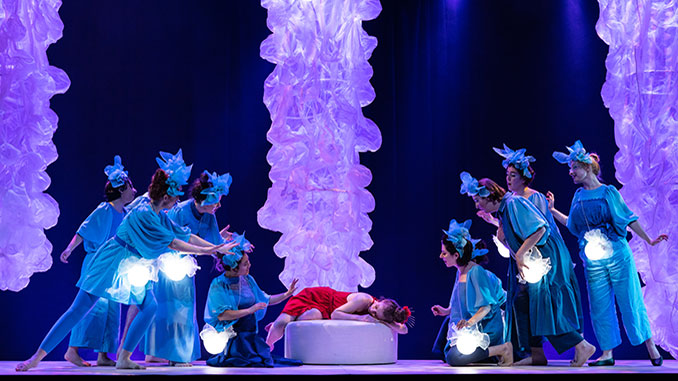 As William Shakespeare’s comic tale of love and intrigue in A Midsummer Night’s Dream has done so for more than 400 years, an enduring sense of appeal similarly accompanies Benjamin Britten’s 1960-premiered enchanting and entertaining adaptation of it.
As William Shakespeare’s comic tale of love and intrigue in A Midsummer Night’s Dream has done so for more than 400 years, an enduring sense of appeal similarly accompanies Benjamin Britten’s 1960-premiered enchanting and entertaining adaptation of it.
Frequently and widely staged and bursting with an assortment of lively characters, the work proves to be a perfect vehicle to challenge young performers.
Opening Wednesday evening, students of the Melbourne Conservatorium of Music, Victorian College of the Arts dug deep to reveal not only the work’s amusing intricacies but also their praiseworthy performance skills to a full house at the campus’ Space 28.
In a collaboration between Master of Music (Opera Performance), Bachelor of Music (Voice), Master of Design for Performance, and Melbourne Conservatorium of Music orchestra students, a deliciously hypnotic production of A Midsummer Night’s Dream coalesced marvellously.
Set in Athens, the story consists of several subplots surrounding the marriage of Theseus and Hippolyta – one entailing the discord between four Athenian lovers, the other concerning a troupe of six amateur actors rehearsing a play to be performed at the wedding. Both groups find themselves in a forest inhabited by fairies while magic and manipulation unfurl.
Within it, themes of navigating love and relationships and the blurring of fantasy and reality combine to reflect the often highly sensitised visions and musings of dreams and consciousness.
The results are lovingly realised in VCA educator Jane Davidson’s dynamic and fluidly moving direction that effortlessly carries the three-act narrative – reduced from Shakespeare’s five – to its conclusion when the mischievous sprite Puck “restores amends” to suggest it all might just be a dream.
Every part of the large open floorspace is deftly employed to create scenic changes. A long, raised platform to the rear, together with three large silken cocoon-like pods, provide height and interest for Oberon’s ethereal domain and later, the actors’ stage for the play-within-a-play as part of Natalie Petrellis’ simplistic design.
Caitlin Thérèse Johnston’s costumes are an eclectic and complimenting mix that includes Oberon and Tytania’s sumptuous, strapped crimson couture, a turquoise endowed train of fairies carrying moonlights and the young Athenian women Helena and Hermia’s similarly coloured and styled dresses to cleverly confuse.
Lighting designer Stephen Hawker’s softly dappled and cocoon colour-changing moods are indispensable to the overall ethereal effect.
The large ensemble cast of 27 artists (an alternate cast perform 8 & 10 December) not only meet the score’s demands vocally, but act with detail and commitment. A handful of standouts deserve mention.
Olivia Federow-Yemm is a revelation, her commanding and captivating Oberon incessantly gesturing with arabesque beauty while deploying evocatively rich, dark and elegant vocals to match – Britten’s score incidentally presents the role of King of the Fairies for both countertenor and contralto.
As Puck, the story’s binding narrator-like sprite, the infectiously endearing Luke Ward darts, leaps and rolls with fabulously gymnastic athleticism and a twinkle in his eye as he puts flesh on the text.
From the moment the tiff between Oberon and Tytania over the changeling boy begins, Uma Dobia adds many a highlight as Queen of the Fairies with her jewelled singing and soaring duets with Federow-Yemm’s Oberon.
And Christopher-Jack Andrew plays Bottom with lashings of buffoonery along with appealingly fortified and resonant vocals and excellent attention to diction others could take note of.
Andrew also takes his place among fellow amateur actors, the mechanicals – Yu-Tien (Denny) Lin as Flute, Cen Wei as Snout, Noah Straughan as Quince, Declan Farr as Snug and James Billson as Starveling – for a hilariously enacted show-stealing Pyramus and Thisbe.
The four lovers – Hartley Trusler as Lysander, Miriam Whiting-Reilly as Helena, Nicholas Beecher as Demetrius and Hannah Kostros as Hermia – each accentuate their versions of love and join in a wonderful post-sleep quartet and the chorus of fairies strung their melodic charm gently across the opera’s course.
Flanking the performance area, Britten’s powerfully seductive and lusciously threaded score was expertly interpreted by conductor Richard Davis on opening night, his 30-plus musicians working together with faultless playing – the brass and woodwind sections provided notable colour and expertise. And the often imaginatively animated and quirky orchestration gave much opportunity to relish instrumental individuality.
In this thoughtfully rendered and performed production, where every scene segues seamlessly as the music creeps and slithers its way forward, Britten’s A Midsummer Night’s Dream soothingly delivers both seriousness and humour for a memorable evening of enchantment.
A Midsummer Night’s Dream
Space 28 – Victorian College of the Arts, Dodds Street, Southbank
Performance: Wednesday 7 December 2022
Season continues to 10 December 2022
Information and Bookings: www.unimelb.edu.au
Image: A Midsummer Night’s Dream – photo by Ben Fon
Review: Paul Selar
